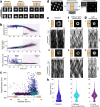FtsZ treadmilling is essential for Z-ring condensation and septal constriction initiation in Bacillus subtilis cell division
- PMID: 33907196
- PMCID: PMC8079713
- DOI: 10.1038/s41467-021-22526-0
FtsZ treadmilling is essential for Z-ring condensation and septal constriction initiation in Bacillus subtilis cell division
Abstract
Despite the central role of division in bacterial physiology, how division proteins work together as a nanoscale machine to divide the cell remains poorly understood. Cell division by cell wall synthesis proteins is guided by the cytoskeleton protein FtsZ, which assembles at mid-cell as a dense Z-ring formed of treadmilling filaments. However, although FtsZ treadmilling is essential for cell division, the function of FtsZ treadmilling remains unclear. Here, we systematically resolve the function of FtsZ treadmilling across each stage of division in the Gram-positive model organism Bacillus subtilis using a combination of nanofabrication, advanced microscopy, and microfluidics to measure the division-protein dynamics in live cells with ultrahigh sensitivity. We find that FtsZ treadmilling has two essential functions: mediating condensation of diffuse FtsZ filaments into a dense Z-ring, and initiating constriction by guiding septal cell wall synthesis. After constriction initiation, FtsZ treadmilling has a dispensable function in accelerating septal constriction rate. Our results show that FtsZ treadmilling is critical for assembling and initiating the bacterial cell division machine.
Conflict of interest statement
The authors declare no competing interests.
Figures





Similar articles
-
FtsZ dynamics in bacterial division: What, how, and why?Curr Opin Cell Biol. 2021 Feb;68:163-172. doi: 10.1016/j.ceb.2020.10.013. Epub 2020 Nov 18. Curr Opin Cell Biol. 2021. PMID: 33220539 Free PMC article. Review.
-
Single-molecule imaging reveals that Z-ring condensation is essential for cell division in Bacillus subtilis.Nat Microbiol. 2021 May;6(5):553-562. doi: 10.1038/s41564-021-00878-z. Epub 2021 Mar 18. Nat Microbiol. 2021. PMID: 33737746 Free PMC article.
-
Treadmilling by FtsZ filaments drives peptidoglycan synthesis and bacterial cell division.Science. 2017 Feb 17;355(6326):739-743. doi: 10.1126/science.aak9973. Science. 2017. PMID: 28209898 Free PMC article.
-
GTPase activity-coupled treadmilling of the bacterial tubulin FtsZ organizes septal cell wall synthesis.Science. 2017 Feb 17;355(6326):744-747. doi: 10.1126/science.aak9995. Science. 2017. PMID: 28209899 Free PMC article.
-
Insights into the Structure, Function, and Dynamics of the Bacterial Cytokinetic FtsZ-Ring.Annu Rev Biophys. 2020 May 6;49:309-341. doi: 10.1146/annurev-biophys-121219-081703. Epub 2020 Feb 24. Annu Rev Biophys. 2020. PMID: 32092282 Free PMC article. Review.
Cited by
-
Inhibition of peptidoglycan synthesis is sufficient for total arrest of staphylococcal cell division.Sci Adv. 2023 Mar 22;9(12):eade9023. doi: 10.1126/sciadv.ade9023. Epub 2023 Mar 22. Sci Adv. 2023. PMID: 36947615 Free PMC article.
-
Structural basis for the interaction between the bacterial cell division proteins FtsZ and ZapA.Nat Commun. 2025 Jul 1;16(1):5985. doi: 10.1038/s41467-025-60940-w. Nat Commun. 2025. PMID: 40593603 Free PMC article.
-
Insights into the assembly and regulation of the bacterial divisome.Nat Rev Microbiol. 2024 Jan;22(1):33-45. doi: 10.1038/s41579-023-00942-x. Epub 2023 Jul 31. Nat Rev Microbiol. 2024. PMID: 37524757 Free PMC article. Review.
-
FtsZ dynamics in bacterial division: What, how, and why?Curr Opin Cell Biol. 2021 Feb;68:163-172. doi: 10.1016/j.ceb.2020.10.013. Epub 2020 Nov 18. Curr Opin Cell Biol. 2021. PMID: 33220539 Free PMC article. Review.
-
GpsB interacts with FtsZ in multiple species and may serve as an accessory Z-ring anchor.Mol Biol Cell. 2025 Jan 1;36(1):ar10. doi: 10.1091/mbc.E24-07-0302. Epub 2024 Nov 27. Mol Biol Cell. 2025. PMID: 39602291 Free PMC article.
References
Publication types
MeSH terms
Substances
Grants and funding
LinkOut - more resources
Full Text Sources
Other Literature Sources
Molecular Biology Databases

